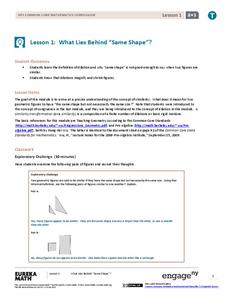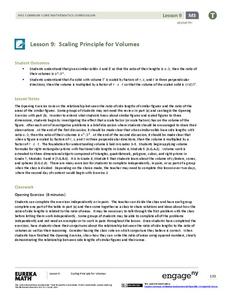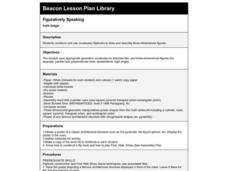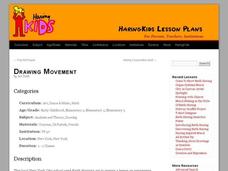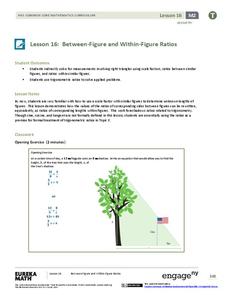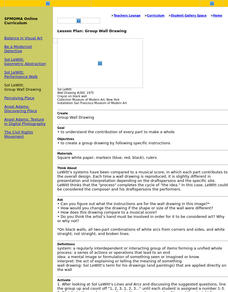EngageNY
Changing Scales
Pupils determine scale factors from one figure to another and the scale factor in the reverse direction. Scholars compute the percent changes between three figures.
Achieve3000
Figurative Language
Similes and metaphors make writing more beautiful and detailed, but can be a little harder to decipher during a first reading. Use a passage from The Man Who Loved Words to show young readers how to think through passages that contain...
EngageNY
What Lies Behind “Same Shape”?
Develop a more precise definition of similar. The lesson begins with an informal definition of similar figures and develops the need to be more precise. The class learns about dilations and uses that knowledge to arrive at a mathematical...
EngageNY
Scaling Principle for Volumes
Review the principles of scaling areas and draws a comparison to scaling volumes with a third dimensional measurement. The exercises continue with what happens to the volume if the dimensions are not multiplied by the same constant.
University of Nottingham
Drawing to Scale: A Garden
See how design and geometry go hand in hand. The activity asks learners to use geometry to design a backyard garden given dimensions of each feature. Scholars work with ratios and scale to develop an accurate scale drawing that includes...
Curated OER
Horse Character: Ceramics Lesson
Animals oftentimes elicit various characteristics which make them symbolic or representative of human feeling, action, or emotion. The class creates horse characters out of clay to show character action and symbolism. This is a great...
EngageNY
How Do Dilations Map Lines, Rays, and Circles?
Applying a learned technique to a new type of problem is an important skill in mathematics. The lesson asks scholars to apply their understanding to analyze dilations of different figures. They make conjectures and conclusions to...
Meadows Center for Preventing Educational Risk, University of Texas at Austin
Lesson 9 - Contractions
Is it do'nt or don't? How about doesn't or does'nt? A instructional activity on contractions helps learners identify, form, and use contractions. Components within the plan include direct instruction on decoding and encoding...
Curated OER
3D Paper-Edge Figure Sculptures
Learners discover visual arts by creating sculptures in class. In this personal expression lesson, students research the Internet and examine different examples of modern sculptures and 3 dimensional art. Learners utilize paper stock,...
Curated OER
Portrait and Figure Drawing
Students practice their drawing skills. For this drawing skills lesson, students complete a self-observation drawing activity and then 3 methods of figure drawing.
Curated OER
Memory & Song, Malagan Figures from New Ireland, Papua New Guinea
Young scholars investigate the uses of images, shapes and colors in classic art sculptures. In this art analysis lesson, students observe Malagan Figures, a type of sculpture from New Guinea, and describe the different ideas and images...
Curated OER
Figuratively Speaking
Third graders construct and use vocabulary flipbooks to draw and describe three-dimensional figures. They utilize worksheets and access websites imbedded in this plan which help them construct their books.
Curated OER
Drawing Movement
Young scholars analyze visual arts by creating drawings in their classroom. In this art analysis lesson, students identify the paintings of Keith Haring by researching the web. Young scholars utilize paper and oil pastels to create...
Scholastic
Frindle Lesson Plan
"Who says a pen has to be called a pen? Why not call it a frindle?" Inspired by this quote from the award-winning novel written by Andrew Celements, this lesson allows children to invent their own terms for common classroom objects,...
Curated OER
Quality Control at Kality Krunchers Dill Pickle Factory
In a hypothetical scenario, food chemists use titration to concoct a brine solution for producing the crunchiest pickles. They also analyze store-bought pickle juices. In addition to reinforcing titration techniques, the lesson requires...
Curated OER
Figurative Slot Sculptures
Middle schoolers create 3-dimensional works of art in the form of slot sculptures. I love this lesson, because it exposes students to a completely different form of art. Everything you need to do to successfully-implement this lesson is...
Ohio Department of Education
Describing and Creating Plane Figures - Grade One
Young mathematicians draw, create, and describe different shapes using triangles. They discuss attributes of the original and created shapes. Pupils classify the created shapes and draw and write in mathematics journals to communicate...
EngageNY
Between-Figure and Within-Figure Ratios
Tie the unit together and see concepts click in your young mathematicians' minds. Scholars apply the properties of similar triangles to find heights of objects. They concentrate on the proportions built with known measures and solve to...
National Security Agency
Awesome Area - Geometry and Measurement
Break out those math manipulatives, it's time to teach about area! Capturing the engagement of young mathematicians, this three-lesson series supports children with learning how to measure the area of squares, rectangles, and other...
Curated OER
Edward Lear, Limericks, and Nonsense
Introduce your class to the delights of nonsense poetry and explore literary devices with the writing of Edward Lear. Learners identify rhyme and meter as well as figures of speech, alliteration, and onomatopoeia in "The Owl and the...
Curated OER
Finding Area of Similar Figures
Students explore the concept of finding area of similar figures. In this finding area of similar figures lesson, students use pattern blocks to construct similar figures. Students trace their construction and find the area. Students...
Curated OER
Applying Proportionality in Scale Drawings
Sixth graders examine a blue print and discuss the reasoning behind using blue prints. In this proportionality lesson, students collaborate with their teammates to create a scale drawing. Once that is complete, 6th graders write a...
Curated OER
Classifying Geometric Figures
Fourth graders recognize and classify geometric figures. In this geometry lesson, 4th graders read the books Shape Up and The Greedy Triangle and prepare a short report on the shapes mentioned in the text. Students compare the polygons...
Curated OER
Group Wall Drawing
Students create a group wall drawing that demonstrate the contributions that each part makes to the whole.




